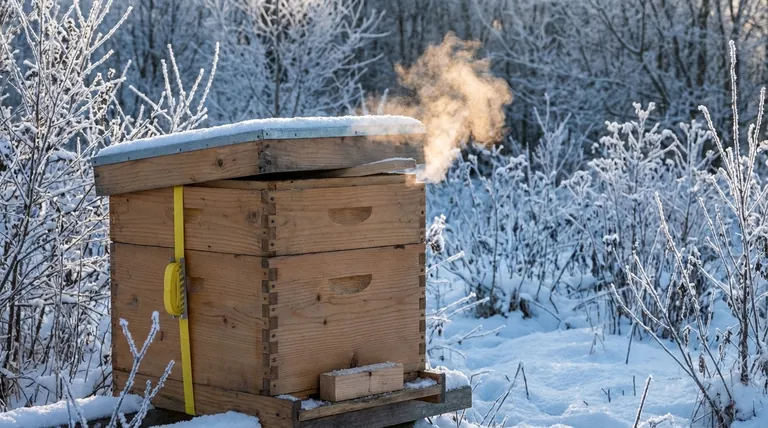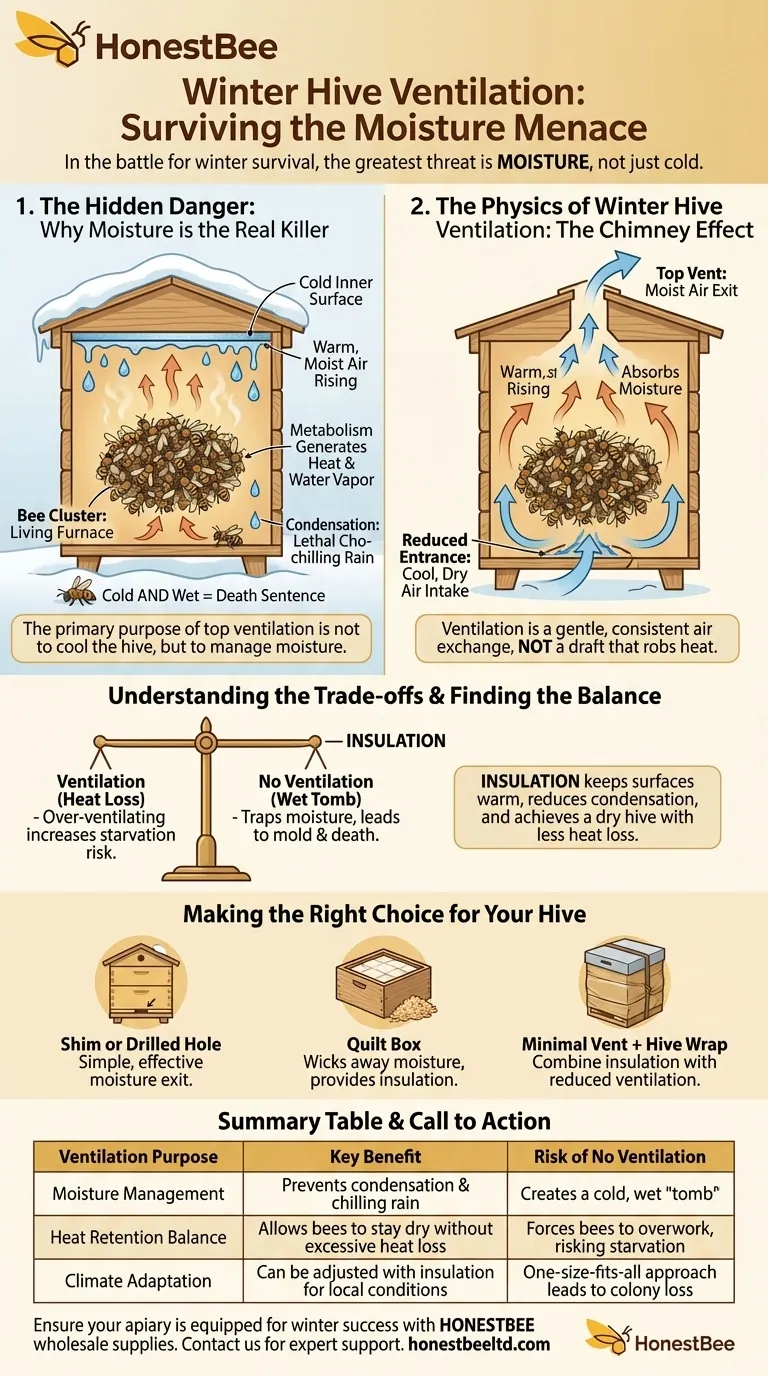In the battle for winter survival, the greatest threat to a honey bee colony isn't the cold; it's the moisture. A small amount of ventilation at the top of the hive is a critical tool to combat this threat. It allows the warm, moist air generated by the bees' metabolism to escape, preventing it from condensing on cold inner surfaces and dripping back down onto the cluster as a lethal, chilling rain.
The primary purpose of top ventilation in winter is not to cool the hive, but to manage moisture. It creates a safe exit for the damp air produced by the bees, keeping the cluster dry and preventing the fatal combination of being cold and wet.

The Hidden Danger: Why Moisture is the Real Killer
To understand ventilation, you must first understand the hive's internal climate. A winter bee colony is a living, breathing engine working constantly to survive the cold.
The Bee Cluster as a Living Furnace
As outside temperatures drop, bees form a tight cluster. By vibrating their flight muscles—essentially shivering—they metabolize their honey stores to generate a remarkable amount of heat at the cluster's core.
The Byproduct of Warmth: Water Vapor
This metabolic process releases two key byproducts: carbon dioxide and a significant amount of warm, moist air. Think of it like the warm, steamy breath you see on a cold day.
How Condensation Forms
This warm, humid air rises. When it hits the cold inner surface of the hive cover or lid, it rapidly cools and condenses back into liquid water, just like condensation on a cold window pane.
Cold and Wet is a Death Sentence
If this condensation has nowhere to go, it will drip back down. A dry bee can withstand freezing temperatures, but a bee that is cold and wet will quickly die from hypothermia. An unventilated hive can literally rain down on the colony, dooming it.
The Physics of Winter Hive Ventilation
Proper ventilation isn't about creating a draft; it's about facilitating a slow, deliberate exchange of air to carry moisture away from the bees.
Creating the "Chimney Effect"
A small opening at the top of the hive works in tandem with a reduced entrance at the bottom. The bees' warmth creates a natural convection current: cool, dry air is drawn in from the bottom, warmed by the cluster, rises while absorbing moisture, and then exits through the top vent.
Ventilation vs. Drafts
It is crucial to distinguish between ventilation and a draft. Ventilation is a gentle, consistent air exchange. A draft is a direct flow of cold wind that robs the cluster of its vital heat. This is why beekeepers use entrance reducers to protect the colony from wind while still allowing for minimal air intake.
Understanding the Trade-offs
Managing a winter hive is a balancing act. Every decision involves a trade-off between retaining heat and expelling moisture.
The Cost of Ventilation: Heat Loss
Any opening that allows moist air to escape will also allow some heat to escape. Over-ventilating a hive can force the bees to consume more honey stores to maintain their core temperature, increasing the risk of starvation.
The Risk of No Ventilation: The "Wet Tomb"
The alternative is far worse. A completely sealed hive traps all the metabolic moisture inside. This creates a cold, damp, and moldy environment where condensation is constant and the bees cannot survive.
Finding the Balance with Insulation
Insulation is the key to finding this balance. Insulating the top and sides of the hive keeps the inner surfaces warmer. Warmer surfaces reduce the amount of condensation that forms in the first place, meaning you can achieve a dry hive with less ventilation and therefore less heat loss.
Making the Right Choice for Your Hive
The goal is to provide just enough ventilation to let moisture out without creating a draft or losing excessive heat.
- If your primary focus is simplicity: A small shim creating a gap under the inner cover or a drilled hole in an upper hive body provides a simple, effective exit for moist air.
- If your primary focus is maximum moisture control: A "quilt box" filled with absorbent material (like wood shavings) placed at the top of the hive wicks away moisture while also providing excellent top insulation.
- If you live in a very cold or windy climate: Combine minimal top ventilation with a significantly reduced bottom entrance and consider wrapping the hive bodies to protect the colony from heat loss.
Ultimately, successful wintering hinges on managing the hive's internal climate to keep your bees warm, but most importantly, to keep them dry.
Summary Table:
| Ventilation Purpose | Key Benefit | Risk of No Ventilation |
|---|---|---|
| Moisture Management | Prevents condensation & chilling rain | Creates a cold, wet "tomb" |
| Heat Retention Balance | Allows bees to stay dry without excessive heat loss | Forces bees to overwork, risking starvation |
| Climate Adaptation | Can be adjusted with insulation for local conditions | One-size-fits-all approach leads to colony loss |
Ensure your apiary is equipped for winter success. Proper hive management starts with the right equipment. HONESTBEE supplies durable, well-designed beekeeping supplies and equipment to commercial apiaries and beekeeping equipment distributors through our wholesale-focused operations. Let us help you protect your investment and maximize colony health. Contact HONESTBEE today for wholesale inquiries and expert support.
Visual Guide

Related Products
- Professional Galvanized Hive Strap with Secure Locking Buckle for Beekeeping
- Black Plastic Beetle Barn Hive Beetle Trap for Beehives
- Multi-Functional Sliding Hive Entrance for Beekeeping
- Professional Pneumatic Wire Embedder for Beehive Frames
- Heavy-Duty Galvanized Steel W-Style Pallet Clip
People Also Ask
- What maintenance is required for hive straps? A Guide to Cam Buckle vs. Ratchet Strap Care
- What is the best length for straps used around beehives? Why 12 Feet is the Industry Standard
- Why are hive straps important for beekeepers? Secure Your Hives Against Wind, Predators & Transport
- What are hive straps and why are they used? Secure Your Hives Against Wind, Predators, and Transport
- What is the advantage of using cam buckle straps? Secure Your Load Fast with Simple, Safe Tensioning



















